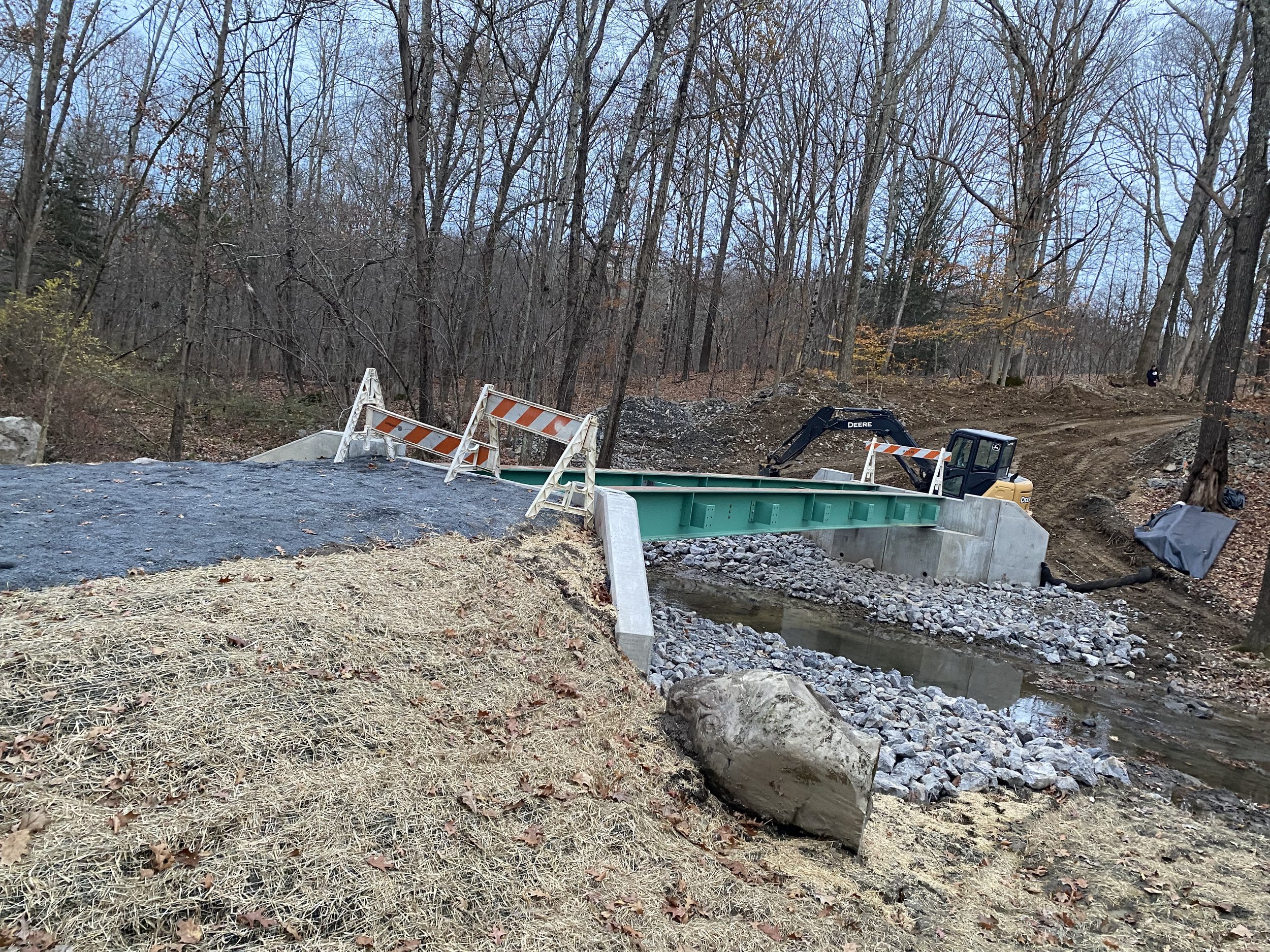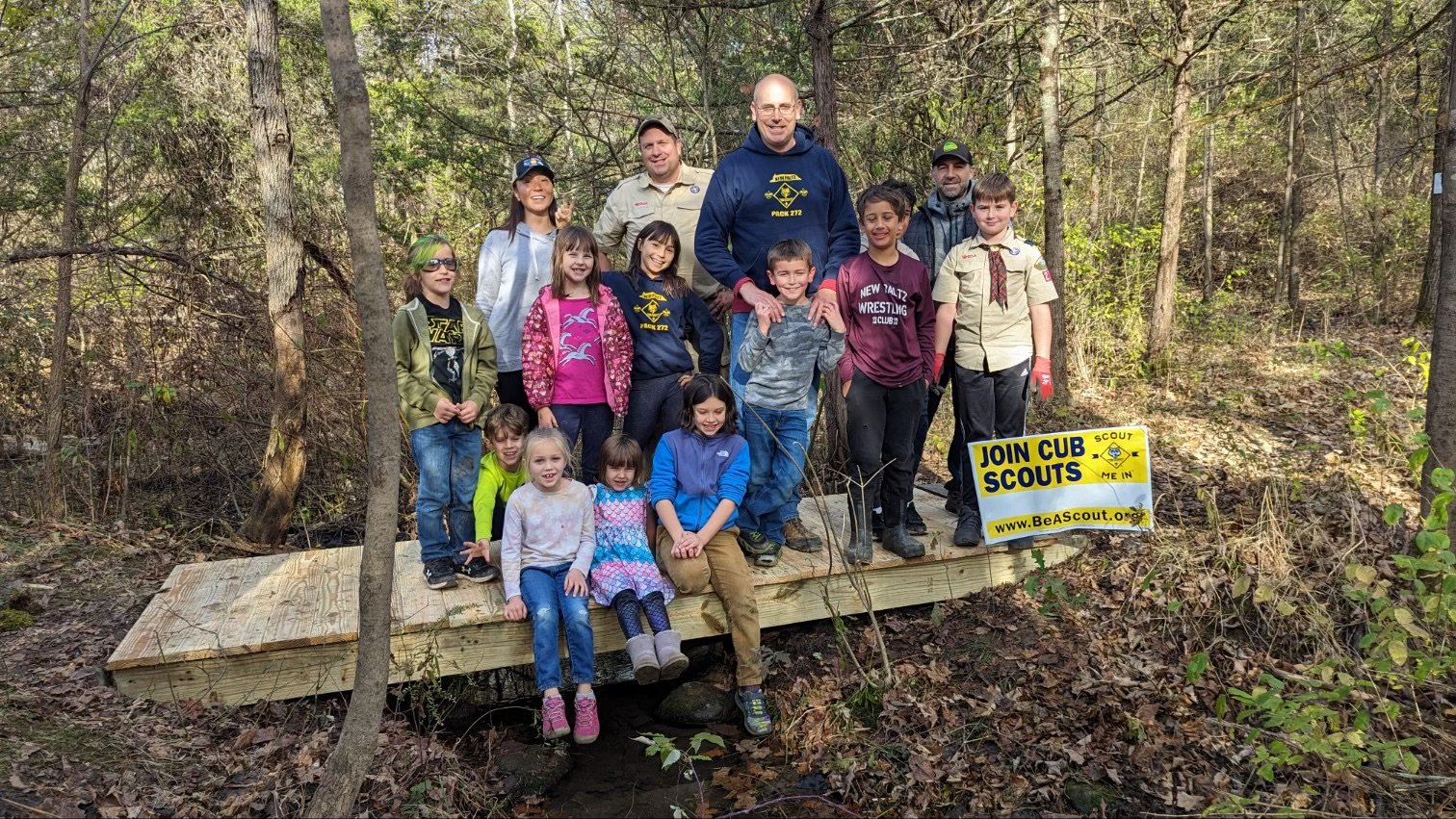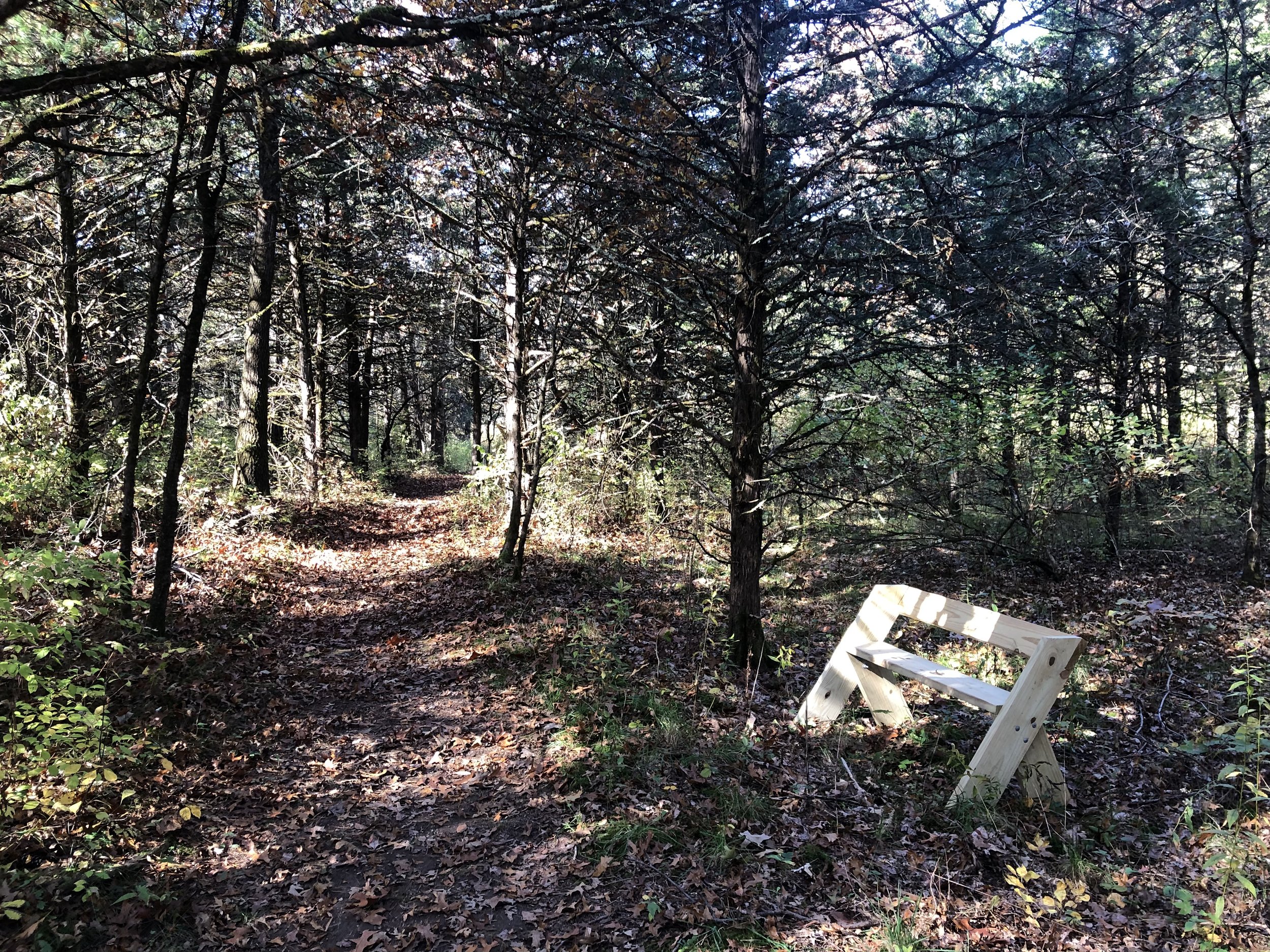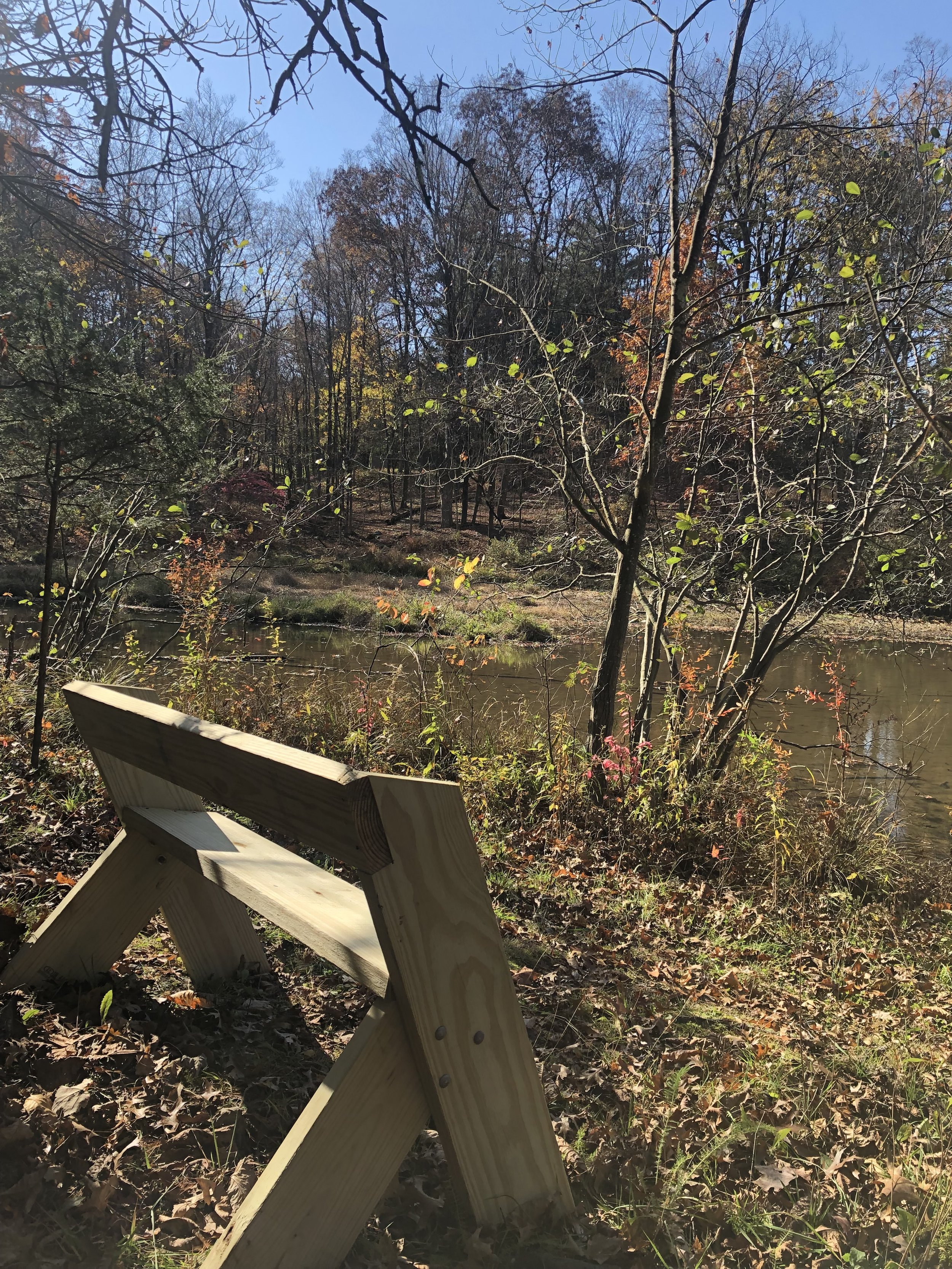Bridges and benches
We have exciting recent improvements to our trails, thanks to invaluable volunteers.
Paul Fargis crafted the benches along the Blue Trail.
Father and son team Ted and Trey Thomas Nitza constructed a crossing over the stream on Yellow. Thanks also to Neil, Abby, Heidi, Kristen, Wendy and Sammy for helping site benches.
Thanks to the Scouts for constructing a new bridge at the Duzine entrance. The old one was in dire need of replacing and this one will get a lot of action from Duzine students!
Finally, you may have noticed the construction work happening near the North Manheim entrance. The Village of New Paltz, with contractor OCE, is at work creating a foundation for a steel bridge that will be a permanent water crossing to replace the old log bridge connecting to the Blue Trail. Our industrious beavers sited their new dam just yards downstream from the log bridge, backing up the water and submerging the logs. The steel bridge will provide a safe, permanent crossing over the stream and reconnect the trails at last!
You may have noticed the construction work happening near the North Manheim entrance. The Village of New Paltz, with contractor OCE, is at work creating a foundation for a steel bridge that will be a permanent water crossing to replace the old log bridge connecting to the Blue Trail. Our industrious beavers sited their new dam just yards downstream from the log bridge, backing up the water and submerging the logs. The steel bridge will provide a safe, permanent crossing over the stream and reconnect the trails at last! Read the HV1 article about it here.
We have exciting recent improvements to our trails, thanks to invaluable volunteers:
Paul Fargis crafted the beautiful new benches along the Blue Trail. Thanks also to Neil, Abby, Heidi, Kristen, Wendy and Sammy for helping site benches.
Father and son team Ted and Trey Thomas Nitza constructed a crossing over the stream on Yellow.
Thanks to the Scouts for constructing a new bridge at the Duzine entrance. The old one was in dire need of replacing and this one will get a lot of action from Duzine students!
New East-West Bog Bridge
A recent visitor to our beautiful forest recently emailed us asking if the beaver dam was man-made. All credit goes to the beavers! After the old one belting the pond at the northern end washed out in heavy rains in 2021, they started work on the new dam just under the old Red Trail log bridge. This backed up the water, forcing closure of the portion of Red Trail that led to the southern part of the Blue Loop. At this point, the waters are so high that the former bog bridge linking the Blue and Green Loops was floating, posing a major water hazard.
Our intrepid Trails Team leaders Adam Harlec and Alex Bartholomew addressed this last weekend by relocating the old bog bridge crossing between the Blue and Yellow loops north to the old beaver pond that’s now a meadow. Thanks for doing this difficult and important work, team!
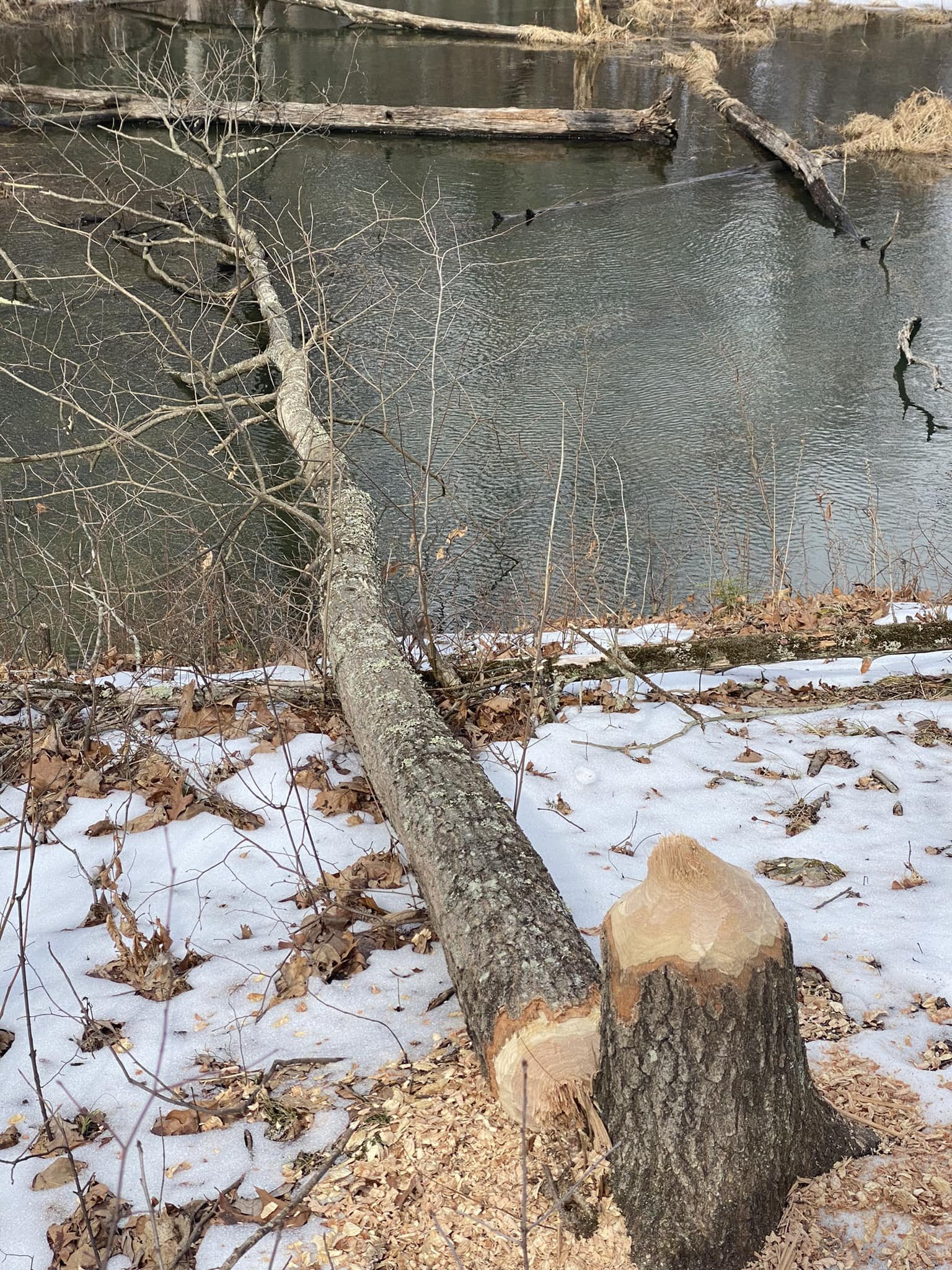

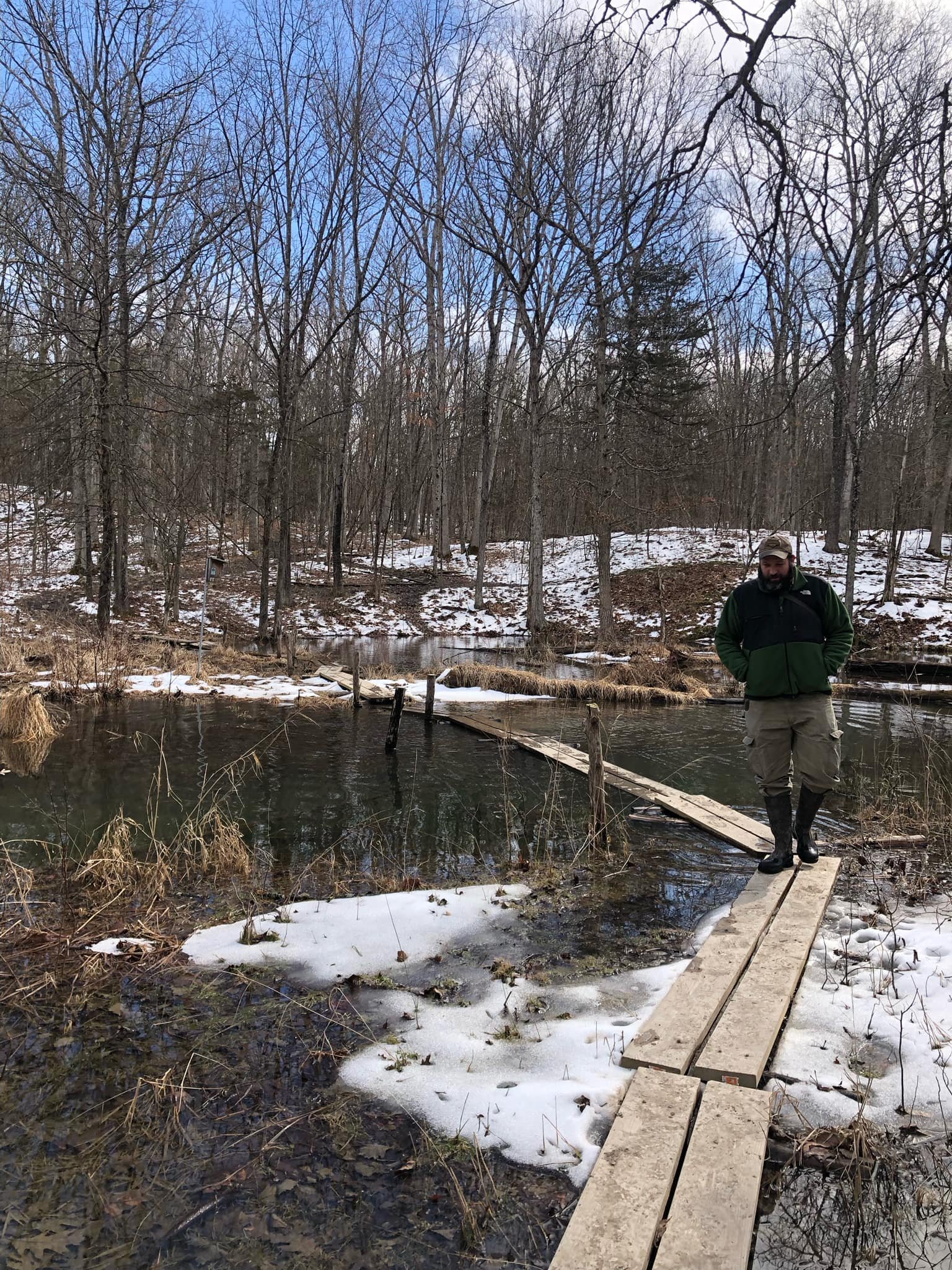
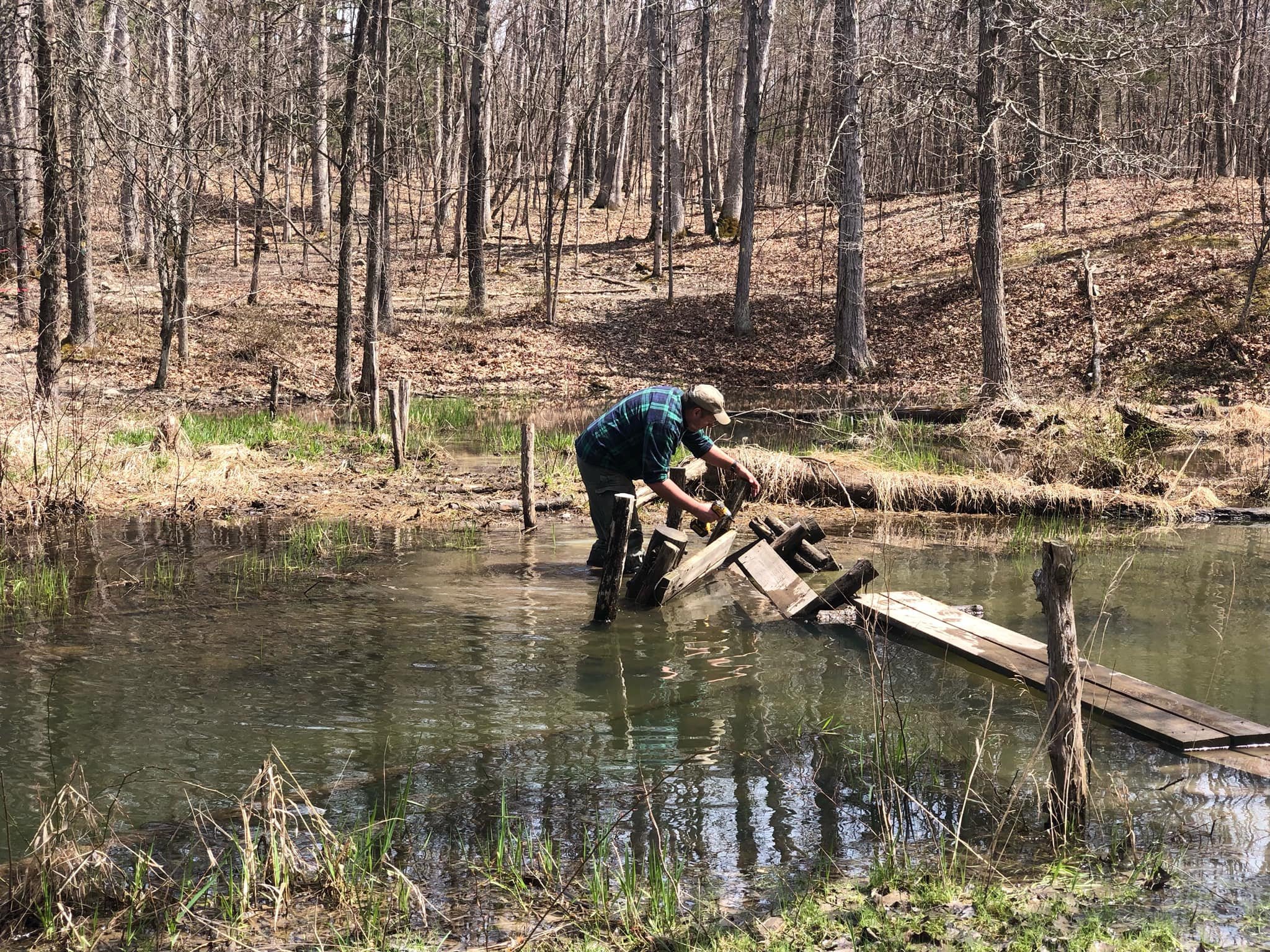
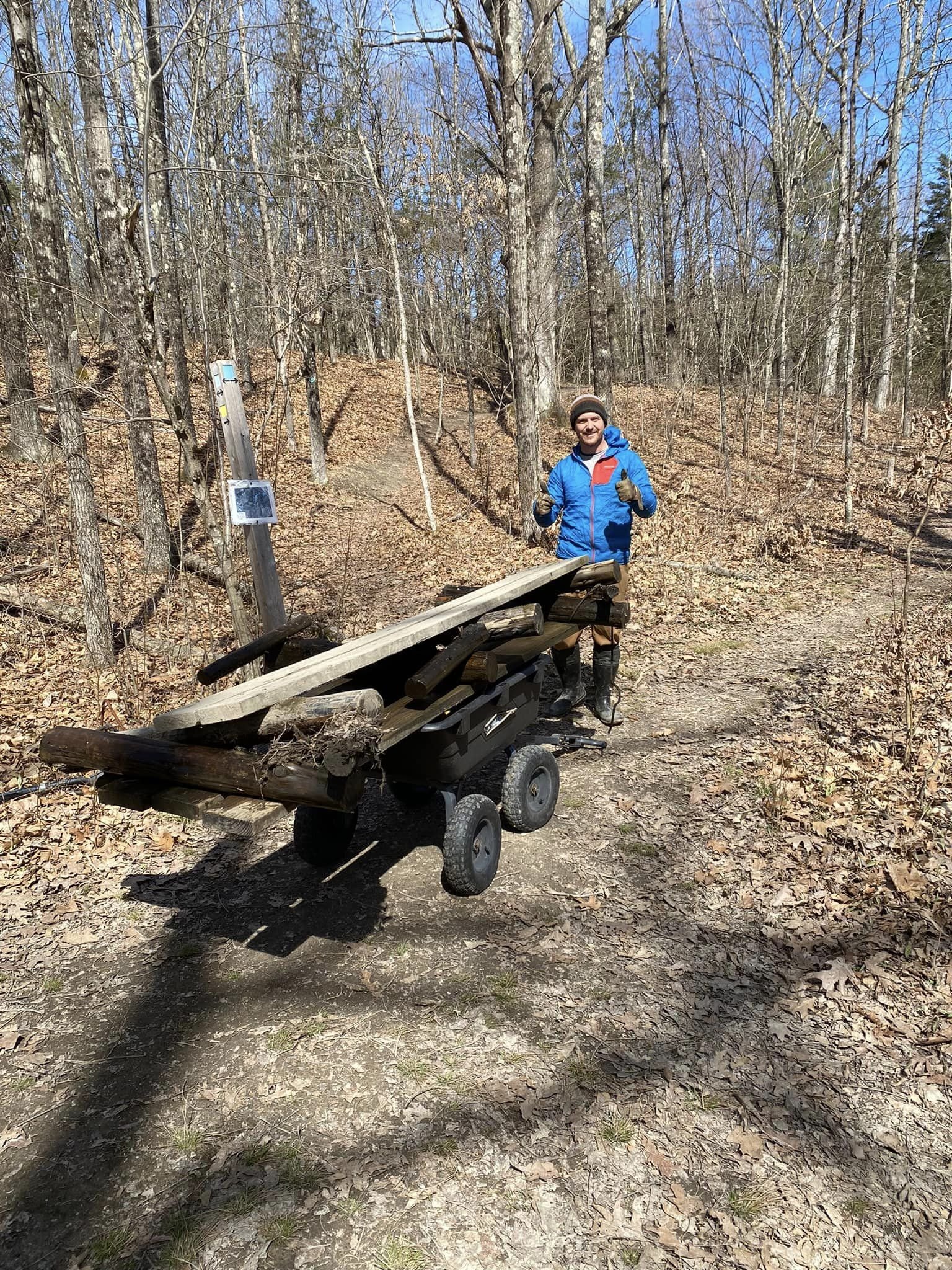
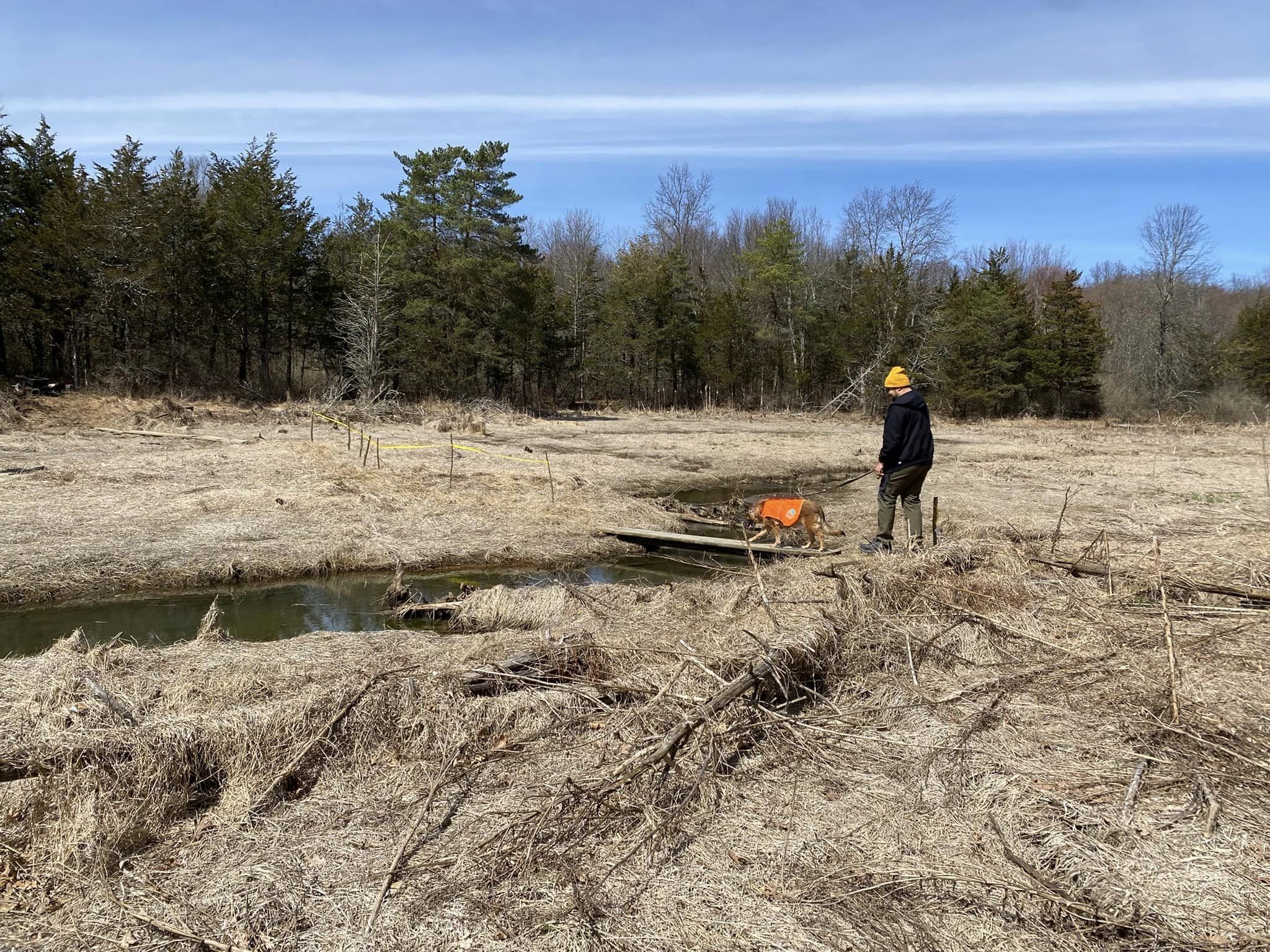
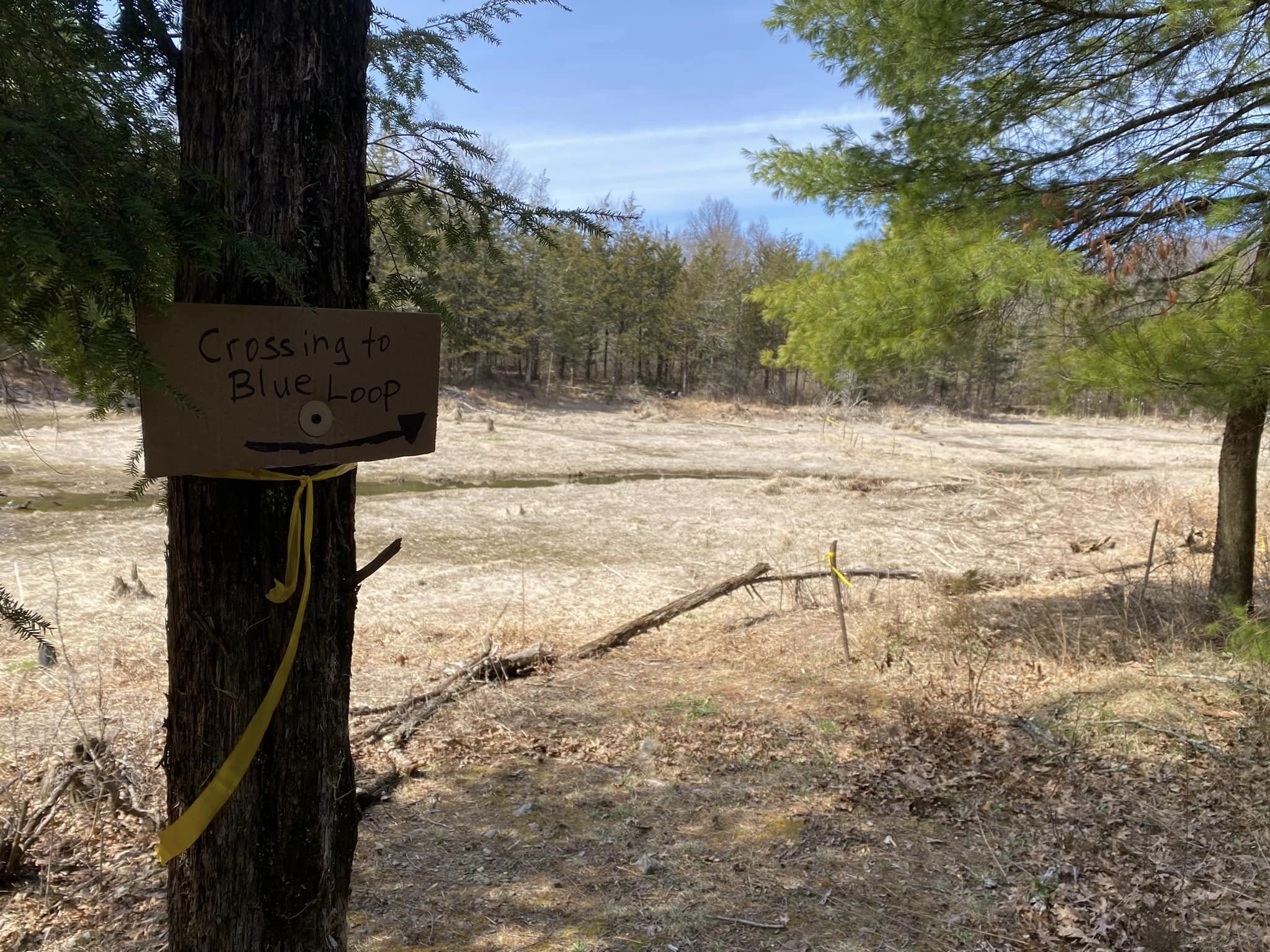
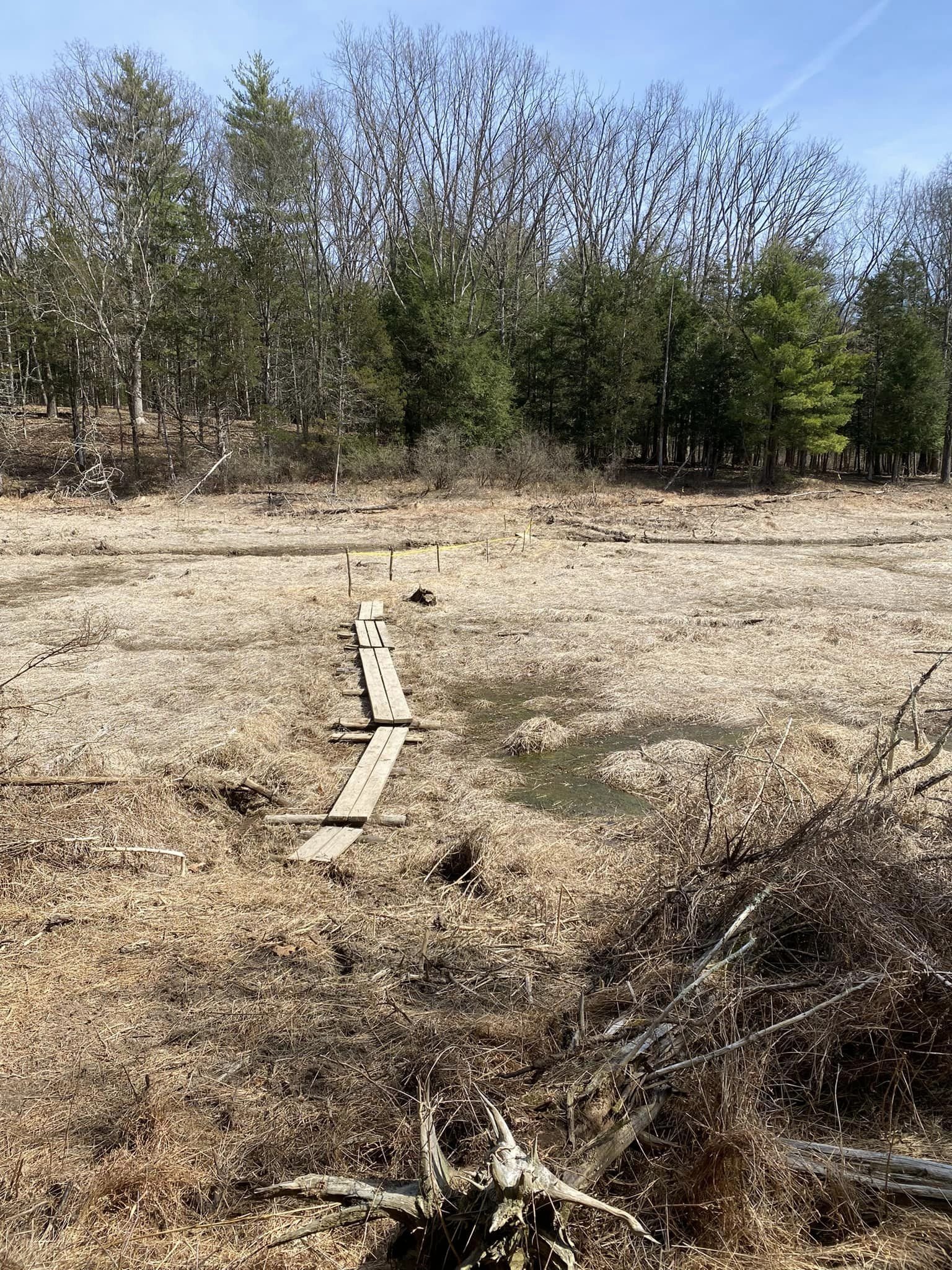
Thank You, Julie!
A million thanks to Julie Seyfert, a driving force behind the creation of Mill Brook Preserve. Though Julie is moving on from the role of Executive Director, we are fortunate to have her temporarily as Director of Environmental Education before she begins her next chapter. At present, she continues to inform and inspire school children in the Preserve and in the classroom. Her legacy is recognized with the dedication of a learning circle in her name. Deepest gratitude for all the energy and heart you put into Mill Brook Preserve, Julie! Wishing you well on your new adventures.
Happy Trails
We have exciting improvements planned for our trails network!
New Trails
After obtaining required approvals from Village and Town of New Paltz Boards, trail construction will begin on a new entrance trail from Hummel Road. Thanks to our neighbors on Hummel for accommodating this addition. Another entrance trail is planned to connect the Orange Trail to Old Mill Road. The Pink Trail will be extended to connect to the Yellow Trail.
New Bridge
The Village of New Paltz has grant funding for a steel and concrete bridge that will replace the old log bridge on the Red Trail. That section connected to the Blue Trail, and has been closed due to high waters caused by the new beaver dam. Please DO NOT use that section of trail. It is not safe for hikers, and detrimental to the sensitive ecology of the wetland. Designed by Peak Engineering and currently out for bid, the new bridge is expected to be completed during the summer of 2023. This project also includes a water crossing on the Green Trail near the Sunset Ridge entrance.
Benches & Bike Racks
Wooden Leopold Benches will be installed at scenic locations along the Blue Trail, and bike racks at entrances. We are currently seeking funding for this project. Please get in touch if you’d like to help!
Nest Box Research
Danielle Takacs ‘23, SUNY New Paltz Biology Department
Tree swallow nestlings in the Millbrook Preserve
Native Cavity Nesters
If you’re a frequent visitor of the Millbrook Preserve, you might have noticed the wooden bird houses placed along the trails. They may look purely decorative, but these houses play a vital role in ongoing research conducted by Biology students at SUNY New Paltz. They are “nest boxes”, providing habitat for many different animals during the breeding season. One group of particular interest is birds. We study birds to give ourselves a better understanding of how to conserve them. Birds face many threats, all of which are often chalked up to “habitat destruction”. With this, we often picture clear cutting of healthy forests. What is not often considered as habitat, however, is the dead trees. Also called “snags”, standing dead and dying trees actually provide more habitat for wildlife compared to when they are alive. We humans tend to remove them from our landscapes, as they appear to be useless, dangerous, and visually unpleasant to us. Yet they are essential for the survival of many different wildlife species; particularly cavity-nesting birds.
“Nature has introduced great variety into the landscape, but man has displayed a passion for simplifying it. Thus he undoes the built-in checks and balances by which nature holds the species within bounds.”
― Rachel Carson, Silent Spring
More than 80 species of North American birds rely on snags for nesting. Primary cavity nesters such as woodpeckers, nuthatches and chickadees excavate the nesting holes. Secondary cavity nesters, as well as many non-avian species, use these holes for foraging, nesting, raising young, storing food, roosting or perching. When we clear all the dead trees from our backyard, we are directly contributing to this habitat destruction. When forest management removes snags from their landscape, they are reducing the available nesting sites for birds such as owls, ducks, woodpeckers, swallows, martins, nuthatches, chickadees, titmice, wrens, bluebirds, warblers, and sparrows, among others.
It is important to realize that a tree’s value does not end with its life. Next time you visit the Millbrook Preserve, try to spot nest cavities in the trees. If you see holes made by woodpeckers, that is a dead tree; perhaps a small animal has made its home inside.
What do the nest boxes tell us?
In addition to providing habitat for a variety of bird species in the preserve, these nest boxes are ideal for studying an array of behaviors in birds that are otherwise extremely difficult to observe (picture yourself in the middle of an expansive forest, tasked with finding several tiny bird nests!). Through this research, students, such as myself, have been given the rare opportunity to become intimately involved with the life of many cavity nesters. Watching them build their nests and raise their young is almost like peeking into a secret world. This experience is unlike any other; it has allowed me to share a new connection with nature, gaining a life satisfaction from its beauty and complexity. But with life, there is always a balance. If you have a nest box of your own, you may notice one frequent visitor is a small brown bird with a black patch on its throat. These guys are social, curious, and quite entertaining to observe. But unless you are a birder, you may not know that to some, they are sworn enemies. This cute little bird is a dominator of nest boxes, oftentimes pushing native cavity nesters out.
Passer domesticus, otherwise known as the house sparrow, is an old-world sparrow in the family Passeridae, originating from Europe and parts of Asia. It was introduced to South Africa, South America, Australia, New Zealand, and North America, perhaps as pest management strategies, but has since taken over. They are the picture-perfect invasive species. They are vigorous breeders, often producing up to four broods where other species produce only one. They are not picky eaters, feeding on seeds, bugs, or the crumbs from your muffin. And finally, they thrive in human environments, nesting in warehouses, factories, garages, porches, and other man-made structures- most notably- our nest boxes. Well-intending citizens put up nest boxes near their homes to observe and support birds, but often end up with a much larger issue. House sparrows are quick to dominate these boxes--occupying them before natives can--or even violently removing established birds. The more habitat we provide them, the more their population grows, escalating the problem exponentially.
If these invasive birds thrive in human-made structures, how can we keep them out of our nest boxes? Biology professor Dr. Kara Belinsky began to tackle this question in 2017, by installing a small nest box network of 18 boxes on the SUNY New Paltz campus. In the first year, a variety of native birds used the boxes farthest from buildings along the forest edges, painting a picture of hope for our campus. In the next year, house sparrows dominated nearly the entire network. But perhaps there is a safe distance from human structures where the nest boxes can be placed that would limit their dominance by house sparrows? The nest boxes along the trails in the Millbrook Preserve this were intended to test this idea. Throughout The Preserve, we placed 60 standard Eastern bluebird nest boxes located at varying distances from the closest human-made structure. Myself and other students from Dr. Kara Belinsky’s lab at SUNY New Paltz have been monitoring these boxes for house sparrow usage every spring and summer. Since the construction of the nest box network in 2020, no house sparrows have nested in any of the boxes, despite having been observed near nest boxes at the edges of The Preserve. Instead, the boxes have been homes to native birds such as tree swallows, house wrens, tufted titmice, black-capped chickadees, and eastern bluebirds, as well as mice, flying squirrels, fishing spiders, wasps and moths. So why aren’t house sparrows occupying the nest boxes in the Millbrook Preserve? It may have to do with nearby population sizes. Perhaps there are not enough sparrows to spill over into The Preserve, while the large population on campus compelled some sparrows to occupy nests at the forest edge there. Future research may focus on expanding the Mill Brook Preserve nest box network into suburban areas surrounding The Preserve in hopes to gain a more thorough understanding of how to best support native cavity nesting species with appropriately placed nest boxes both near and far from large house sparrow populations and small nature Preserves.
More information about House Sparrows
Summer research students Danielle Takacs and Sam Mustafa checking a nest box
Fishers are Thriving!
Fishers are thriving in Mill Brook Preserve. Using tracking and trail cameras we have been monitoring their presence and their numbers appear to be increasing. Fishers were extirpated from this region but have made a comeback after being reintroduced to nearby states to control porcupine populations. They tend to return or stay within the home range. Our den camera caught two fishers checking it out together. Though known for their elusiveness, a few of us have encountered them on the trail. One has a tan ruff around the collar that makes it look a bit like its cousin the wolverine.
Fishers are thriving in Mill Brook Preserve! Using tracking and trail cameras, we have been monitoring their presence. For three years we have been watching fisher activity at a dead tree with a hole at the top.
There is a fisher with a tan ruff around her collar that has come back two years in a row at nesting time. She could have been using a nest box in the tree to raise young. One video shows an uncharacteristically ungraceful ascent up the tree, possibly because of a belly full of babies. But despite four cameras surrounding the tree last year, we never saw babies. So far she hasn’t returned this year. We have seen blood-tinged urine by another dead tree, suggesting a female in estrus. We’re now watching a second tree.
At least three fishers likely call the Mill Brook Preserve part of their territory. Last spring, a camera at a fox den caught two young fishers checking it out together. Neither of these had the tan ruff around the collar that the one at the tree has.
A diverse ecosystem, where predator/prey relationships are in balance, is our goal. Large, contiguous forests with mature and/or old growth trees provide what they need. Fishers were extirpated from this region but were reintroduced and have made a big comeback. They have a tendency to return or stay within the home range. It’s our pleasure to host them!


